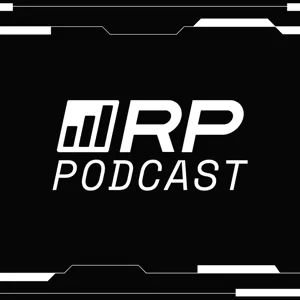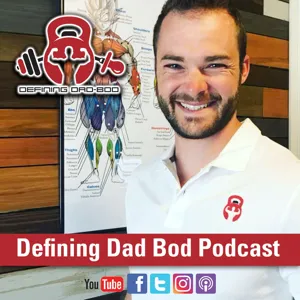Podcast Summary
Stimulus, Resources, and Facilitators: The Three Layers of Muscle Building: Effective muscle building requires a balance of stimulation, resources, and facilitators. Stimulate muscle growth with weight training, provide energy and materials through nutrition, and create an optimal environment with rest and hormonal balance.
Building muscle involves a three-layered process: stimulators, resources, and facilitators. Stimulators, such as weight training, initiate the muscle growth process. Resources, like nutrition, provide the necessary energy and materials for growth. Facilitators, including rest, recovery, and proper hormonal balance, create an optimal environment for muscle growth. These three categories work together in the stimulus-recovery-adaptation (SRA) model, with stimulation leading to recovery and adaptation. Training stimulates muscle growth, and food provides the energy and raw materials for recovery and adaptation. The analogy of a construction site can help illustrate this concept: the stimulus is the laborers, resources are the supplies, and facilitators are the weather conditions. To effectively build muscle, one must prioritize all three aspects.
Understanding Muscle Growth: Molecular Machines at Work: Effective training methods involve signaling molecular machines like mTOR and p70 s6 kinase to build muscle proteins, not just applying force to muscles.
Muscle growth is a result of molecular machinery within our muscles responding to specific stimuli. These molecular structures, such as ribosomes and muscle proteins, play crucial roles in building muscle proteins and detecting force. The mTOR and p70 s6 kinase pathways are central to muscle growth, acting as the "governor" of muscle growth. To maximize muscle growth, we need to understand how to effectively turn on these molecular machines, which can be achieved through various training methods. It's important to note that force through a muscle alone does not trigger muscle growth; instead, it's the molecular force transduction sensors that need to be signaled. Progressive overload, or increasing the stimulus, is essential to promote muscle growth and prevent muscle atrophy. Ultimately, muscle growth is a complex process that involves intricate molecular interactions, and understanding these mechanisms can lead to more effective training strategies.
The Role of Tension in Muscle Growth: Tension is a crucial factor in muscle growth, achieved through various methods including isometric holds, concentric and eccentric contractions, and time under tension. Up to 80% of differences in hypertrophy can be attributed to tension.
Tension plays a crucial role in muscle growth. This tension can be generated through various methods such as isometric holds, concentric and eccentric contractions, and even extreme stretches. The more tension that is detected by the muscle, the greater the hypertrophic response. Time under tension, or the total amount of time a muscle is subjected to tension, is a key predictor of muscle growth. This can be achieved through slow, controlled reps or faster reps with a higher volume. Tension is believed to account for up to 80% of the differences in training-induced hypertrophy.
The optimal repetition range for muscle growth is between 5 and 30 reps: The total volume of work in weightlifting, measured by reps, weight, and time, determines muscle growth, but sets of 5 to 30 reps provide the optimal tension for muscle growth.
The amount of muscle growth stimulus from weightlifting is largely determined by the total volume of work, which is measured by the number of repetitions, weight, and time. However, the optimal repetition range is between 5 and 30 reps, as anything less than 5 reps doesn't provide enough total tension, while anything above 30 reps provides too little tension per rep. The muscles have tension detectors that require a certain level of tension for a sufficient duration to stimulate growth. A study by Brad Schoenfeld showed that 3 sets of 10 reps and 7 sets of 4 reps, with equal volume, resulted in the same muscle growth, but the 7 sets of 4 reps were reported to be more challenging and less sustainable. Therefore, sets of 5 to 30 reps are the most effective for muscle growth. This concept will be explored further in upcoming episodes.
The ideal range for muscle growth in weightlifting is a bell curve with varying reps and weights depending on the exercise and individual.: Focus on deep, controlled eccentric stretches for optimal muscle growth in weightlifting, as eccentric tension provides the most benefit.
There's an optimal range for heat (or intensity in the context of weightlifting) that leads to effective cooking (or muscle growth). Too little heat (or intensity) won't get the job done, while too much can cause damage. The same principle applies to weightlifting, where the ideal range for muscle growth is not a clear-cut answer, but rather a bell curve with varying ideal reps and weights depending on the specific exercise and individual. Additionally, the type of tension applied (concentric, isometric, or eccentric) and the muscle length during that tension also impact muscle growth. Eccentric tension, which involves lengthening muscles while contracting, provides the most growth. Therefore, architecting reps with a focus on deep, controlled eccentric stretches is the best approach for maximizing muscle growth.
Embracing discomfort for muscle growth: Focus on the hardest part of a lift with proper control for muscle growth, avoid shortened partials, and embrace discomfort to push past comfort zones
To effectively build muscle, focusing on the hardest part of the lift with proper control of the eccentric and lengthened partials is crucial, despite it being painful and uncomfortable. This approach, often referred to as lengthened partials, involves performing only the bottom portion of a lift, where tension and stretch are maximized. It's essential to avoid shortened partials, which primarily engage the strongest part of the lift and provide minimal benefits for muscle growth. The debate around the effectiveness of full range of motion versus lengthened partials is ongoing, but the consensus is to avoid shortened partials at all costs. In essence, muscle growth comes from pushing past comfort zones and embracing the discomfort of challenging exercises.
Importance of full range of motion exercises for muscle growth: Full range of motion exercises with proper eccentric control and loaded stretches are essential for muscle growth, as they engage muscle fibers fully and stimulate cellular growth mechanisms.
While doing partial repetitions with lighter weights may allow for more time in the hypertrophy zone and less time recovering, it is not as effective or efficient as performing full range of motion exercises with proper eccentric control and loaded stretches. These full range of motion exercises, even if done with faster concentric movements, should be focused on with a deep stretch and a controlled descent to engage the muscle fibers fully and stimulate cellular growth mechanisms. The burn or metabolites produced during these exercises may serve as signals for muscle growth, making the discomfort and soreness worthwhile. While the research is not clear enough to prescribe only partial repetitions, it is important to avoid neglecting the bottom stretch and eccentric control in favor of lifting heavier weights.
Maximizing tension, metabolites, and the pump for effective hypertrophy training: Effective hypertrophy training involves maximizing tension, metabolites, and the pump to promote muscle growth. Tension causes micro-tears, metabolites provide additional stimulus, and the pump increases muscle size.
Effective hypertrophy training involves maximizing tension, metabolites, and the pump. Tension is important because it causes micro-tears in muscle fibers, leading to growth. Metabolites increase as you get closer to muscle failure, providing additional stimulus for growth. The pump, or muscle swelling, is directly correlated to hypertrophy, with studies showing that those who experience larger pumps during workouts grow more muscle. However, some bodybuilders may prioritize tension and metabolites over the full range of motion and deep stretch, potentially missing out on the full benefits of hypertrophy training. While they may still see some growth, they may have to do more sets to achieve the same results, potentially leading to increased joint stress and potential long-term damage. Ultimately, the most effective hypertrophy training involves finding ways to maximize all three factors in each set.
Finding the right balance between stimulating muscle growth and minimizing damage: To maximize muscle growth, find the optimal balance between stimulating hypertrophy and minimizing damage through the right frequency, intensity, and nutrition.
Effective training for muscle growth involves finding the right balance between stimulating hypertrophy and minimizing damage. Overdoing it can lead to excessive soreness and hinder progress. It's important to remember that not everyone who trains hard achieves the same results, and those who didn't make it to the top may have valuable insights to share. The mechanisms of hypertrophy require adequate nutrition and rest to function optimally. Training is like repainting a house – applying the right amount of pressure to stimulate growth without causing excessive damage is key. Going too far can result in negative consequences and hinder progress. The common philosophy that "more input equals more output" should be applied wisely, and finding the optimal frequency and intensity for training is crucial for maximizing muscle growth.
Maximize muscle growth with the right approach, not by overworking yourself: Focus on full range of motion, controlled movements, and manageable loads for optimal muscle growth, rather than overdoing it and compromising potential results
When it comes to working out and muscle growth, moderation is key. Overdoing it and getting excessively sore to the point of taking more than a week to heal is not beneficial, as it may result in less growth and more time spent recovering. Instead, focusing on a full range of motion with controlled, eccentric movements and a load that allows for at least 30 repetitions is recommended. Heavier loads that are not manageable for multiple reps may not be intelligent for the long term. The next episode will discuss practical applications of these principles, and listeners are encouraged to sign up for the RP Hypertrophy app for a simplified understanding of these concepts. In essence, the goal is to maximize growth with the right approach, not by overworking oneself and compromising the potential for optimal results.





